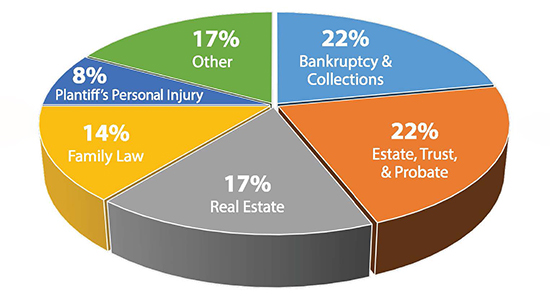
Lawyers enter this profession for a variety of reasons. Many see it as a calling – they want to be in a position to help people resolve their problems, make a decent living, and find intellectual challenges along the way.
As most every lawyer will tell you, though, deadlines, difficult clients, and overwork due to a heavy caseload can make for some stressful days. These pressures can cause mistakes that sometimes lead to an Office of Lawyer Regulation grievance or a malpractice claim.
There isn’t one right way to be a lawyer. It is called the “practice of law” for a reason. As a lawyer, you’re looking for the best fit for each client, the best strategy and the best solution. On the path to accomplishing all that, there are plenty of obstacles that even the best lawyers sometimes have difficulty avoiding.
Many lawyers firmly believe they’ll never have to worry about a grievance or a claim. But mistakes are made even by the most experienced lawyers, and every lawyer faces challenges keeping every client happy.
Brian Anderson, senior claims attorney for Wisconsin Lawyers Mutual Insurance Co. (WILMIC) in Madison, says, “Sometimes lawyers don’t know how close they came to a malpractice claim – nothing triggered the problem so it remained undiscovered, or the client didn’t pursue the issue, either because the client really liked the attorney or didn’t want to spend the time or money pursuing it. It may be small, it may be large, but it’s often something that was simply overlooked.”
While mistakes can occur and things can happen with little or no warning, understanding the most common mistakes lawyers make and where the risks are can help you avoid those mistakes and risks and reduce the chances of a malpractice claim.
Who’s Making the Mistakes
Malpractice claims do not discriminate. They happen to all types of lawyers in all different age groups and stages of practice. However, there are trends. According to statistics compiled by WILMIC:
-
Newer lawyers are targeted for a malpractice claim at a much lower rate than more experienced lawyers. Roughly 11 percent of WILMIC claims were made against lawyers in their first five years of practice, compared to 30 percent against lawyers who have been in practice 10-20 years.
-
“Dabbling” is very risky. Roughly 45 percent of all claims involve areas of practice in which lawyers practice less than 10 percent of the time.
-
The riskiest areas of practice, statistically, are bankruptcy and collections; real estate; estate, trust, and probate; family law; and plaintiffs’ personal injury.
For the past 30 years, plaintiffs’ personal injury work generated more claims than any other area of practice. That has changed in the past couple years. Now, bankruptcy and collections work, as well as estate planning, top the list of areas of practice with the most claims. Each of those areas generated approximately 22 percent of WILMIC’s claims last year. Real estate accounted for 17 percent, and family law 14 percent.
Anderson says it’s difficult to put a finger on why personal injury claims are down. “It may be that the number of accident claims is down in Wisconsin. Cases are more likely to resolve earlier through mediation. Claims are more likely after a trial, the outcome in which the client may be disappointed. We would also hope that attorneys are paying attention to risk management strategies.
“That being said, it is important to note that WILMIC’s overall numbers since we started over 30 years ago still reflect the fact that plaintiff personal injury work has been and continues to be the riskiest area of practice to insure, from both a frequency and severity standpoint. When it comes to severity dollars paid, personal injury work leads the way by a long shot, representing over 28 percent of the indemnity dollars WILMIC has paid since 1986. The next closest area in terms of indemnity payments is real estate, at 17 percent.”
Anderson cautions personal injury lawyers that, “This area of practice will always be a source of claims, and we may be enjoying a lull in these types of claims that is not sustainable.”
Top Five Areas of Law Producing the Most
Malpractice Claims in 2016

Most Common Mistakes in the Past Year
The types of errors committed by lawyers are tracked in several basic categories.
1) Administrative Procedures and Calendaring. At the top of the list are mistakes related to procedure and scheduling – 24 percent of WILMIC claims are a result of mistakes in
these areas.
“This includes several things,” Anderson says. “Attorneys sometimes fail to properly calendar something. Or when they do, they procrastinate and fail to get something done in a timely manner. Procrastination is something we see quite often in claims. If lawyers could stay ahead of their calendars, they would avoid many of the mistakes that get them into trouble.”
Part of the problem, of course, is that few of us are really in total control of our calendars. Something unexpected can pop up and hijack your schedule at any time. That’s when mistakes can occur.
Lawyers miss deadlines for many reasons. They might have procrastinated, or they might be overwhelmed by their workload, causing something to fall through the cracks. Or maybe they have a bad calendaring system.
Anderson says, “It is always a good idea for a lawyer to examine his or her own calendaring procedures and determine if there are any weaknesses in the system. A backup or redundant calendaring system can make a big difference.”
2) Planning Errors. Second on the list of most common mistakes are planning errors in choice of procedure. “Knowing the law isn’t enough,” says Anderson. “Lawyers need to identify the right issues to get to the right solutions. And framing the legal question properly goes a long way to good representation for the client.”
Identifying the client’s goals makes a difference, too. Anderson says it’s often not enough to simply do what the client asks and nothing else. “The client may not know enough to ask about other options. A lawyer should be in a position to explain the benefits and drawbacks so the client can make an informed decision.”
And finally, Anderson adds, write a good engagement letter. “Identifying the client’s goals in writing can allow the client and the lawyer to discover other issues that need to be addressed. The letter also makes clear what the lawyer believes needs to be done to accomplish the defined goals and what the lawyer has or has not been retained to handle.”
3) Investigation and Discovery. The third most common mistake is “inadequate discovery and investigation.” All lawyers have had clients who don’t want them to spend too much time on the case, as a way to save on fees.
Sometimes a complete and thorough investigation is not done because the lawyer is too busy and trusts the client to provide all the information needed for the case. This can lead to serious problems down the road, for both the client and the lawyer. If you’re willing to take a case, be committed enough to do it well, including investigating and verifying the facts. If you can’t make that commitment, strongly consider not taking the case.
4) Inadequate Knowledge of the Law. Failing to know the law and apply it properly is fourth on the list of common mistakes. Anderson says, “The law is broad, so take the time to check it regularly. The law often changes, too. Court opinions sometimes change the law. The legislature enacts new statutes every year. Your client is relying on you to keep up with those changes.”
5) Poor Lawyer-client Communication. The mistake that may be among the most important is failing to communicate effectively with your client. If communication between a lawyer and his or her client suffers, the risk of a malpractice claim soars.
Lack of good communication with your client may be the easiest mistake to prevent, according to Anderson.
“If your office procedure includes a good calendaring system with appropriate redundancy, excellent client communications, and file management, you will greatly reduce or even eliminate a significant amount of risk. Great client communication practices are the best insulation a lawyer has from claims and grievances. It is also invaluable in the defense of a legal malpractice claim.”
Avoiding a communication breakdown means writing the letter, making the phone call, and making sure the client understands. “It’s matching up client expectations with reality, and making sure those expectations line up with the lawyer’s expectations,” Anderson says. “That’s when you have great communication.”
Conclusion
The good news for lawyers is that many of these mistakes are avoidable with the proper amount of attention. Anderson says missing deadlines generally results from human error or procedural flaws. Shoring up your administrative procedures, working to continuously improve your client communication skills, researching the law, and making sure you thoroughly investigate your clients’ cases, as well as selecting the right clients, can greatly help in avoiding claims or grievances.
While you can’t and shouldn’t spend all your time worrying about mistakes, Anderson says you should at least be aware of ways to avoid them. “We want lawyers to be aware of ways to avoid mistakes, but not be overwhelmed or consumed by the potential risks,” he says. “A little wisdom and common sense can go a long way when practicing law.”
